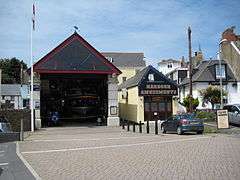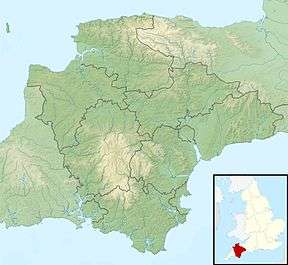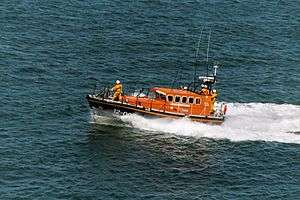Ilfracombe Lifeboat Station
Ilfracombe Lifeboat Station is the base for Royal National Lifeboat Institution (RNLI) search and rescue operations at Ilfracombe, Devon in the United Kingdom. The first lifeboat was stationed in the town in 1828 and the present station was opened in 1996. For 29 years a second boat was operated from Morte Bay at Woolacombe. It operates a Shannon-class all-weather lifeboat (ALB), operational number 13-09 and named The Barry and Peggy High Foundation, Ilfracombe also operates a D-class (IB1) inshore lifeboat (ILB), under the operational number D-717 and named the Deborah Brown ll.
| Ilfracombe Lifeboat Station | |
|---|---|
 | |
 Ilfracombe | |
| General information | |
| Type | RNLI Lifeboat Station |
| Location | Broad Street, EX34 9EE |
| Country | United Kingdom |
| Coordinates | 51.2100°N 4.1162°W |
| Opened | First boat 1828 Current building 1996 |
| Owner | Royal National Lifeboat Institution |
History
A pilot boat was fitted out as a lifeboat for the town in 1828, and a new lifeboat was bought by local people in 1850 which operated from a boat house in Hiern's Lane near the harbour. The RNLI started its service in Ilfracombe in 1866 when a boat house was built near the pier at the bottom of Lantern Hill with a slipway nearby. Alterations to the pier in 1871 meant that the slipway was lost and the boat then had to be taken along the road to the harbour whenever it needed to be launched. The boat house was demolished in 1893 to allow a larger building be built for the new Co-operator No. 2 which, at 37 feet (11 m) was 3 feet longer than the previous boat. This boat house was used until 1996 when it was replaced by a new facility near the slipway at the harbour.[1]
In 1871 a lifeboat was stationed at Morte Bay near Woolacombe, about 6 miles (10 km) south west of Ilfracombe. When the lifeboat was needed west of Morte Point a crew came out from Ilfracombe on a carriage. It proved difficult to launch into strong winds blowing onto its west-facing beach and so the station was closed in May 1900. The lifeboat was transferred up the coast to Watchet; the boat house has since been incorporated into a café known as the Boat House Café.[2]
The first motor lifeboat at Ilfracombe was placed on station in March 1936. This was a 32 feet (9.8 m) Surf lifeboat, a type that was designed for work close inshore. It was replaced by a more conventional 35 feet (11 m) Liverpool-class boat in 1945, which allowed the Surf boat to be sent to the Netherlands where there was an acute shortage of lifeboats at the end of World War II.[1] The all-weather boat has been supported by an inflatable inshore rescue boat since 1991.[3]
Service awards
The volunteer crews of the RNLI do not expect reward or recognition for their work, but the records include many rescues that have been recognised by letters, certificates and medals from the RNLI management. This list is just some of the most notable.
On 13 November 1949 the Richard Silver Oliver was launched to assist the SS Monte Gurugu which had lost sinking near Morte Point after losing her rudder in a severe storm. After pulling the casualty clear of the shore, the lifeboat took the 23 crew aboard and safely back to Ilfracombe. Coxswain Cecil Irwin was awarded an RNLI silver medal for his work.[1]
In a Force 8 gale on September 1984, the Liberty was dragging her anchor just 50 yards (46 m) from the shore when the Lloyds II reached her. The lifeboat's crew managed to get a line secured to the yacht and towed her into the harbour. A bronze medal was awarded to Coxswain David Clemence for his courage, leadership and seamanship.[1]
Area of operation
The Mersey-class lifeboat at Ilfracombe has an operating range of 145 nautical miles (269 km) and a top speed of 17 knots (31 km/h).[4] Adjacent lifeboats are stationed at Appledore to the West, and The Mumbles to the North, along with an ILB at Minehead to the East.[5]
Current lifeboats
- Shannon-class 13-09 The Barry and Peggy High Foundation[6]
- IB1 D-717 Deborah Brown II which is launched and recovered using Talus MB-H amphibious launch tractor (T-92)[7]
Former lifeboats
'ON' is the RNLI's sequential Official Number; 'Op. No.' is the operational number painted onto the boat.
Pulling and sailing lifeboats
| ON | Name | Built | At Ilfracombe | At Morte Bay | Class |
|---|---|---|---|---|---|
| – | –[8] | 1828 | 1828–? | – | – |
| – | Lady Franklin[8] | 1850 | 1850–? | – | – |
| – | Broadwater[8] | 1866 | 1866–1886 | – | – |
| 225 | Grace Woodbury[2][9][Note 1] | 1871 | – | 1871–1892 | Peake |
| 53 | Co-operator No. 2[8][10] | 1886 | 1886–1893[Note 2] | – | Peake |
| 339 | Theophilus Sidney Echalaz[2][11] | 1892 | – | 1892–1900[Note 3] | Peake |
| 355 | Co-operator No. 2[8][12] | 1893 | 1893–1920 | – | Peake |
| 596 | Richard Crawley[13][14] | 1910 | 1920–1936[Note 4] | – | Peake |
Motor lifeboats

| ON | Op. No. | Name | Built | At Ilfracombe | Class |
|---|---|---|---|---|---|
| 779 | – | Rosabella[13][15] | 1936 | 1936–1945[Note 5] | Surf |
| 794 | – | Richard Silver Oliver[16][17] | 1937 | 1945–1952[Note 6] | Liverpool |
| 904 | – | Robert and Phemia Brown[13][18] | 1952 | 1952–1966[Note 7] | Liverpool |
| 986 | 37-19 | Lloyds II[13][19] | 1966 | 1966–1990[Note 8] | Oakley |
| 1165 | 12-007 | Spirit of Derbyshire[13][20] | 1990 | 1990–2017 | Mersey |
Notes
- Grace Woodbury was originally named Jack-a-Jack but was renamed in 1872.
- The first Co-operator No. 2 was used as a demonstration lifeboat from 1893 until 1907.
- Theophilus Sidney Echalaz was transferred to Watchet where it was renamed W.H.G. Kingston.
- Richard Crawley had been the Southsea Lifeboat from 1910 until 1918.
- Rosabella was sold for further service at Terschelling, Netherlands and is now preserved at Aalsmeer.
- Richard Silver Oliver was stationed at Cullercoats 1937–1939, Newquay 1940–1945 and Cricceth 1953–1961. It was sold in 1963 for further service in Chile.
- Robert and Phemia Brown was sold in 1967 and subsequently used as a yacht.
- Lloyds II was stationed at Sheringham until 1993 but then broken up.
- Alec Dykes saw further service at Bude and in the RNLI relief fleet but was withdrawn from service in 2009.
- Deborah Brown was transferred to the RNLI relief fleet in 2009.
References
- Leach, Nicholas (2009). Devon's Lifeboat Heritage. Chacewater: Twelveheads Press. pp. 46–48. ISBN 978- 0-906294-72-7.
- Leach N. (2009) p. 45
- "Ilfracombe History". RNLI. Archived from the original on 23 October 2009. Retrieved 19 November 2010.
- Wake-Walker, Edward (2008). The Lifeboats Story. Stroud: Sutton Publishing. p. 112. ISBN 978-0-7509-4858-6.
- Denton, Tony (2010). Handbook 2010. Shrewsbury: Lifeboat Enthusiasts Society. p. 68.
- "Lifeboats". Ilfracombe RNLI. Retrieved 13 June 2017.
- Denton T. (2010) p. 64
- Leach N. (2009) p. 46
- Denton T. (2010) p. 5
- Denton T. (2010) p. 2
- Denton T. (2010) p. 7
- Denton T. (2010) pps. 8–9
- Leach N. (2009) p. 47
- Denton T. (2010) pps. 16–17
- Denton T. (2010) pps. 22–23
- Leach N. (2009) pps. 47–48
- Denton T. (2010) pps. 24–25
- Denton T. (2010) pps. 28–29
- Denton T. (2010) pps. 32–33
- Denton T. (2010) p. 38
- Denton T. (2010) p. 58
- Denton T. (2010) p. 60
- Denton T. (2010) p. 62